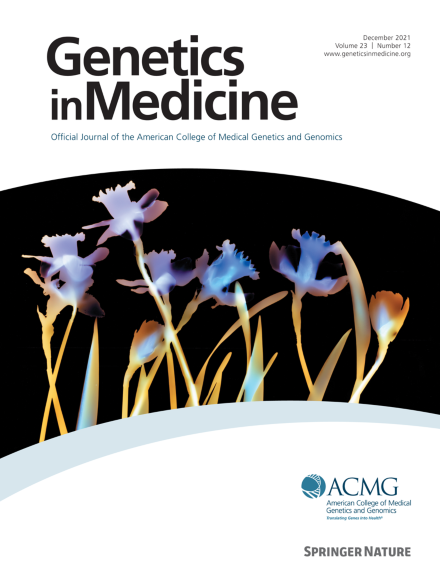接受快速基因组测序的儿童的长期随访。
IF 6.6
1区 医学
Q1 GENETICS & HEREDITY
引用次数: 0
摘要
目的:探讨重症监护下接受快速基因组测序(RGS)治疗的儿童的长期发展轨迹。方法:我们检查了67例危重儿科患者的电子健康记录(EHR),这些患者在6至8年前接受了RGS,集体初始诊断率为46%。结果:中位随访时间为6.2年(IQR 4.0 ~ 7.2年)。与未确诊的患者相比,rgs诊断的患者的平均随访时间更长(5.9年对4.8年,p = 0.026),每个随访年的亚专科预约次数更多(9.4年对6.9年,p = 0.036)。随访期间死亡率为9%。患者平均每随访年再入院2.1次,每随访年住院28.1天。在随访期间,44名患者(66%)在电子病历中记录了新的表型。7名患者在随访期间接受了临床驱动的重新分析,产生了一个新的诊断。作为本研究的一部分,对RGS进行了系统的再分析,确定了四种新的候选诊断。结论:在重症监护病房住院期间接受RGS的儿科患者在随后的几年中仍然是高医疗保健利用率,无论RGS是否确定诊断。此外,该队列中三分之二的患者在随访期间有记录的表型变化,这表明在RGS后的几年中临床发展动态。本文章由计算机程序翻译,如有差异,请以英文原文为准。
Long-term follow-up of children who received rapid genomic sequencing
Purpose
To explore long-term trajectories of children who received rapid genome sequencing (RGS) in intensive care settings.
Methods
We examined the electronic health records of 67 critically ill pediatric patients who received RGS 6 to 8 years ago with a collective initial diagnostic yield of 46%.
Results
The median length of follow-up was 6.2 years (interquartile range 4.0-7.2 years). RGS-diagnosed patients had a longer average follow-up time compared with undiagnosed patients (5.9 years vs 4.8 years, P = .026) and more subspecialty appointments per follow-up year (9.4 vs 6.9, P = .036). Mortality during the follow-up period was 9%. Patients averaged 2.1 hospital readmissions per follow-up year and 28.1 hospitalized days per follow-up year. Forty-four patients (66%) had a documented new phenotype in the electronic health records during their follow-up period. Seven patients received clinician-driven reanalysis during the follow-up period, yielding 1 new diagnosis. Systematic reanalysis of RGS performed as part of this study identified 4 new candidate diagnoses.
Conclusion
Pediatric patients who receive RGS during intensive care unit hospitalizations continue to be high health care utilizers in subsequent years, regardless of whether RGS identified a diagnosis. Additionally, two-thirds of this cohort had a documented phenotypic change over the follow-up period, indicating dynamic clinical evolution in the years after RGS.
求助全文
通过发布文献求助,成功后即可免费获取论文全文。
去求助
来源期刊

Genetics in Medicine
医学-遗传学
CiteScore
15.20
自引率
6.80%
发文量
857
审稿时长
1.3 weeks
期刊介绍:
Genetics in Medicine (GIM) is the official journal of the American College of Medical Genetics and Genomics. The journal''s mission is to enhance the knowledge, understanding, and practice of medical genetics and genomics through publications in clinical and laboratory genetics and genomics, including ethical, legal, and social issues as well as public health.
GIM encourages research that combats racism, includes diverse populations and is written by authors from diverse and underrepresented backgrounds.
 求助内容:
求助内容: 应助结果提醒方式:
应助结果提醒方式:


